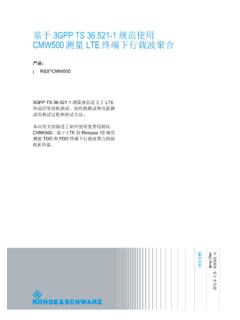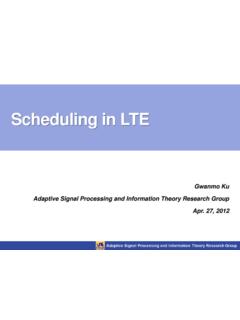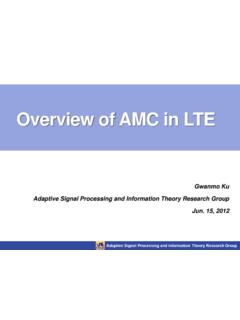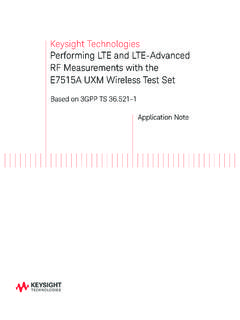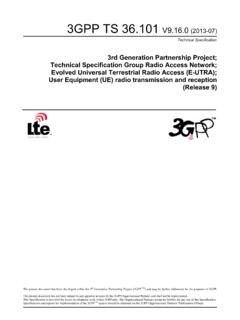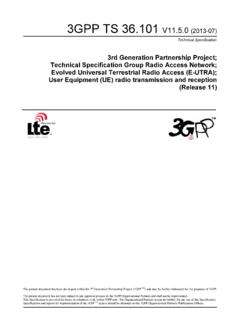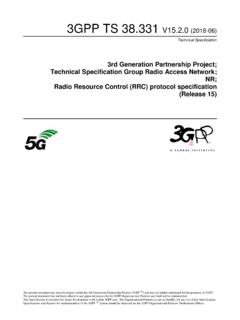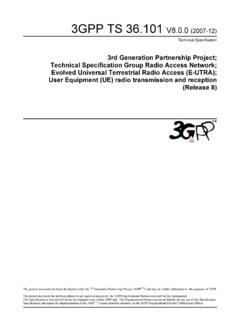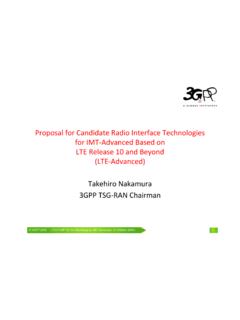Transcription of Fundamentals of Channel Emulation - octoScope
1 Fundamentals of Channel Emulation Mar-2012 Outline What is Channel Emulation and why is it critical for MIMO systems? Channel modeling standards and technologies Channel model statistics MIMO/OTA Channel emulator implementation Competitive analysis 2 Wireless Channel Frequency and time variable wireless Channel Multipath creates a sum of multiple versions of the TX signal at the RX Mobility of reflectors and wireless devices causes Doppler-based fading Multiple antenna techniques are used to optimize transmission in the presence of multipath and Doppler fading 3 Channel Quality MIMO=multiple input multiple output Multipath and Flat Fading In a wireless Channel the signal propagating from TX to RX experiences Flat
2 Fading Multipath/Doppler fading 4 Time +10 dB 0 dB Multipath fading component -15 dB flat fading component Multipath reflections occur in clusters. Wireless Channel 5 Per path angular spread Composite angular spread Composite angular spread Multipath cluster model Multipath and Doppler fading in the Channel Validating Radio DSP A variety of Channel conditions and complex multiple-antenna algorithms for adapting to these conditions make a Channel emulator necessary for developing and testing radio DSP 6 TX RX Controlled programmable Channel conditions Multipath Doppler Noise Channel Emulator Development and Test of MIMO Development and test of MIMO systems requires a Channel emulator to emulate multipath and Doppler fading in a variety of
3 Wireless channels. Adaptive multiple antenna techniques, including TX and RX diversity, spatial multiplexing and beamforming involve sophisticated open and closed loop algorithms that must be tested under a range of controlled (emulated) Channel conditions. Traditional Channel emulators connect to DUTs conductively without antennas. Antennas and antenna arrays are part of the Channel models. 7 Channel Emulator DSP RF Front End RF Front End Digital IQ (CPRI/OBSAI) RF or digital IQ coupling to DUTs Multiple RF modules can connect for scalability Problematic for MIMO and beamforming systems where antennas are integral to performance SISO Channel Emulator x x x.
4 Where T is the number of taps in the TDL h1 h2 hT + Input Output TX RX Complex time-variable coefficients, h Delay 2 Delay 3 Delay T MIMO Channel Emulation Logic 2 x 4 Example H1,1 H2,1 H1,2 H2,2 H2,3 H1,3 + + + + H1,4 H2,4 N1 N2 M1 M2 M3 M4 [h1,1 1, h1,1 2, .. , h1,1 T] [h2,4 1, h2,4 2, .. , h2,4 T] [h2,1 1, h2,1 2, .. , h2,1 T] [h1,2 1, h1,2 2, .. , h1,2 T] [h2,2 1, h2,2 2, .. , h2,2 T] [h1,3 1, h1,3 2, .. , h1,3 T] [h2,3 1, h2,3 2, .. , h2,3 T] [h1,4 1, h1,4 2, .. , h1,4 T] Complex tap coefficients Tapped Delay Line, H n,m AWGN Generator Doppler filter Spatial correlation matrix Polarization matrix Tap coefficient factors 1,1 h1,1k Complex Tap Coefficient Generator AWGN Generator Doppler filter Tap coefficient factors 1,2 h1,2k.
5 AWGN Generator Doppler filter Tap coefficient factors N,M hN,Mk .. AWGN Generator Doppler filter Tap coefficient factors n,m hn,mk .. where k is the tap number and h is the time-variable complex coefficient Doppler Filter Doppler filter Notes Classical Specified for most 3 GPP Channel models; Classical = Jakes; variations of classical filter used in the industry include Classical 3 dB and Classical 6 dB; Bell Specified for Channel models; variations of this filter include Bell-spike, which is used by model F to model a 40 km/hour spike in the spectrum Static Models LOS on first tap; used in custom Channel modeling Flat Can also be implemented using RF attenuators via an identity matrix ( connecting inputs to outputs through attenuators) Rounded Variations of this filter include Rounded 12 dB Gaussian Constant phase Butterworth Pure Doppler Doppler filter FIR or IIR AWGN Generator Notes on Doppler Filter Implementation AWGN sources are connected to Doppler filters that provide the desired spectral shape of the fading.
6 The Doppler filter is IIR in the octoFade implementation. For models, the filter is Bell-shaped for models A through F and Bell-Spike for model F. The Bell spectrum models fading due to walking-speed motion in the environment at an average speed of km/hr. The spike in the Bell-Spike spectrum adds the effect of a vehicle moving at an average speed of 40 km/hr. For 3 GPP models, the Doppler spectrum is Classical. Tap Coefficient Factors + x Fluorescent light + 1+ , 11+ x Tap coefficient factors n,m hn,mk where k is the tap number, h is the time-variable complex coefficient, K is Rician K-factor LOS component NLOS component PDP weighting Interpolation to TDL clock rate Notes on Tap Coefficient Factors The parameter K (Rician K-factor) determines the relative strength of the LOS and NLOS components and is set based on the chosen model.
7 The 1+ term models the LOS component. The 11+ term models the NLOS component. The LOS component can only be present on the 1st tap. If the distance between the transmitter and the receiver is greater than the distance to 1st reflector (typically a wall in the indoor environment ) then LOS component is not present. The presence of LOS is a configuration parameter that can be enabled or disabled. The first tap s LOS component isn t Doppler filtered. Thus, if LOS is present, the power spectrum on the first tap deviates from the Bell spectrum since it includes both the LOS and the NLOS components. If LOS is present, the PDF and CDF of the 1st tap are Rician.
8 If LOS is not present the PDF and CDF on the 1st tap are Rayleigh. On all other taps the PDF and CDF are always Rayleigh. represents the Power Delay Profile (PDP) weighting, summed over all the clusters that contribute power for the kth tap. It reflects how strong the total power is at tap k. Correlation Matrix The spatial correlation matrix is a function of the angular spread of each cluster, angle of arrival (AoA) and angle of departure (AoD). models assume that RX and TX antenna systems are uniform linear arrays with equally spaced antenna elements. Spatial correlation is implemented using the Kronecker product of the transmit and receive correlation matrices, Rtx and Rrx, respectively.
9 These matrices are comprised of correlation coefficient terms, , that depend on the PAS, AoA, AoD, tap powers and distance D between antenna elements. Fox computes the real and imaginary parts, RXX(D) and RXY(D), respectively, for each . This allows spatial correlation based on the complex field ( , using =RXX(D)+jRXY(D)) or real power ( , using =RXX2(D) +RXY2(D)). ReceiverTransmitterAoAAoDAntenna element spacing, DAngle of arrival (AoA), Angle of departure (AoD) Antenna spacing, D Correlation and Polarization MU-MIMO modeled for AoD and AoA Polarization matrix added since devices are expected to have cross-polarized antennas 16 AoA = angle of arrival AoD = angle of departure Outline What is Channel Emulation and why is it critical for MIMO systems?
10 Channel modeling standards and technologies Channel model statistics MIMO/OTA Channel emulator implementation Competitive analysis 17 Channel Models - Summary 18 Model [1] Distance to 1st wall (avg) # taps Delay spread (rms) Max delay # clusters A* test model 1 0 ns 0 ns B Residential 5 m 9 15 ns 80 ns 2 C small office 5 m 14 30 ns 200 ns 2 D typical office 10 m 18 50 ns 390 ns 3 E large office 20 m 18 100 ns 730 ns 4 F large space (indoor or outdoor) 30 m 18 150 ns 1050 ns 6 * Model A is a flat fading model; no delay spread and no multipath The LOS component is not present if the distance between the transmitter and the receiver is greater than the distance to 1st wall.
